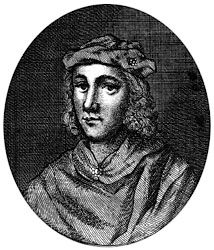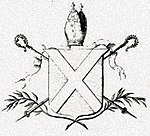Related Research Articles

Constantine, son of Áed was an early King of Scotland, known then by the Gaelic name Alba. The Kingdom of Alba, a name which first appears in Constantine's lifetime, was situated in modern-day Scotland.
Óengus mac Fergusa was king of the Picts from 820 until 834. In Scottish historiography, he is associated with the veneration of Saint Andrew, the patron saint of Scotland.
The House of Alpin, also known as the Alpínid dynasty, Clann Chináeda, and Clann Chinaeda meic Ailpín, was the kin-group which ruled in Pictland and then the kingdom of Alba from the advent of Kenneth MacAlpin in the 840s until the death of Malcolm II in 1034.

The origins of the Kingdom of Alba pertain to the origins of the Kingdom of Alba, or the Gaelic Kingdom of Scotland, either as a mythological event or a historical process, during the Early Middle Ages.

Culture of Scotland in the High Middle Ages refers to the forms of cultural expression that come from Scotland in the High Medieval period which, for the purposes of this article, refers to the period between the death of Domnall II in 900, and the death of Alexander III in 1286. The unity of the period is suggested by the immense breaks which occur in Scottish history because of the Wars of Scottish Independence, the Stewart accession and transformations which occur in Scottish society in the fourteenth century and afterwards. The period differentiates itself because of the predominance of Gaelic culture, and, later in the medieval, Scoto-Norman French culture.
Fothad II was the bishop of St Andrews (1059–1093) for most of the reign of King Máel Coluim III mac Donnchada. Alternative spellings include Fodhoch, Fothach and Foderoch, and Fothawch. A "Modach filius Malmykel" is mentioned in a grant, dated 1093, as the bishop of S. Andrews. As this bishop is certainly Fothad II, his father was a man named Máel Míchéil.
Cellach I is traditionally said to have been the first Bishop of the Scots, the bishopric later based at St. Andrews. He is mentioned in the historical writings of Walter Bower and Andrew of Wyntoun as a bishop of St. Andrews, but no pre-15th century sources say anything more than merely "Bishop". Wyntoun and Bower make him bishop as early as the reign of King Giric of Scotland (877x878-885x889). He was still bishop in the reign of King Causantín II of Scotland in 906 when, "in his sixth year King Causantín and Bishop Cellach met at the hill of belief near the royal city of Scone and pledged themselves that the laws and disciplines of the faith, and the laws of churches and gospels, should be kept in conformity with the customs of the Gaels". One interpretation of this passage is the demise of the "Pictish church" to the reforming Gaels, however it is certain that by the 15th century the bishop-list of the principal Scottish see was looking back at Cellach as its first bishop. His death date is unknown, but unsurprisingly he was certainly dead by the 960s when his successor Fothad I died as bishop.
Fothad I is the second alleged Bishop of the Scots (906x955). We know he had the status of "bishop" during the reign of King Dub mac Maíl Coluim because the Chronicle of the Kings of Alba has his death in the period of his reign (962-967). Such a date is supported by the Irish annals, and according to the Annals of the Four Masters, he died in 963. According to the latter source, he was Fothadh, mac Brain, scribhnidh & espucc Insi Alban; that is, "Fothad, son of Bran, scribe and bishop of the islands of Scotland". This entry taken on its own obviously places some doubt on his status as a bishop of St Andrews. It is only because he is mentioned as a bishop of St. Andrews in the bishop-lists of Walter Bower and Andrew of Wyntoun that he is identified with this see; however no pre-15th century sources actually confirm this, although it is true that there was definitely a bishop of this name in the 11th century. Bower, however, gives some explanation, telling us that Fothad "was driven out by King Indolff; and after his expulsion from the see he lived for 8 years". This Indolff, or King Idulb mac Causantín reigned between 954 and 962. If we take both Bower's statement and the obit reported in the Annals of the Four Masters to be correct, this means that Fothad was expelled in 955. Although it is unlikely anyway, he could not have been bishop before the year 906, when we know his predecessor Cellach was still bishop. That he died in 963 as "espucc Insi Alban" allows the possibility that he transferred his see to Iona or elsewhere on the western coast of Scotland after 955, although this is just conjecture.
Máel Ísu I is the third alleged Bishop of Cennrígmonaid, equivalent to latter day St Andrews. He is mentioned in the bishop-lists of the 15th-century historians Walter Bower (Malisius) and Andrew of Wyntoun (Malice) as the successor of Fothad I, and it is claimed that he reigned as bishop for eight years. If Máel Ísu's predecessor did get expelled from the bishopric in 955,, and if Máel Ísu's reign really was eight years, then Máel Ísu would have held the bishopric between the years 955 and 963.
Máel Muire is the fifth alleged bishop of St Andrews, though at that period the bishop of the Scots did not necessarily have one episcopal seat. He is mentioned in the bishop-list of the 15th-century historian Walter Bower as the successor of Cellach II, the latter of whom reign for at least 25 years. Nothing else is known about Máel Muire. However, he cannot have been bishop before 988/9, because that is the earliest likely date for the end of the episcopate of his predecessor Cellach. The next firm date for any bishop of the Scots is 1055, when the Annals of Tigernach records the death of bishop Máel Dúin, and obviously this date is too far ahead to be of very much use.
Cellach II is the fourth alleged Bishop of the Scots, the predecessor of the later St Andrews bishopric.
Máel Ísu II is the sixth alleged Bishop of the Scots, equivalent to latter day St. Andrews. He is mentioned in the bishop-lists of the 15th-century historians Walter Bower and Andrew of Wyntoun as the successor of Cellach II. We have no direct dates for Máel Ísu II's episcopate, but the indirect evidence for his predecessors suggests that he was bishop in the late 10th and/or early 11th century.
Ailín is the seventh alleged Bishop of St Andrews. He is mentioned in the bishop-lists of the 15th-century historians Walter Bower and Andrew of Wyntoun as the successor of Máel Ísu II. We have no direct dates for Ailín's episcopate, but the indirect evidence for his predecessors suggests that he was bishop in the early 11th century. Name occurs in Latin form as Alwinus, the form for the Anglo-Saxon name Ælfwine, although it may be a form for Alpín. A similar name, Alguine, occurs in the Book of Deer, and two Mormaers of Lennox had the name Ailín, similarly rendered as Alwinus.
Máel Dúin is the eighth alleged Bishop of St Andrews. He is mentioned in the bishop-lists of the 15th-century historians Walter Bower and Andrew of Wyntoun as the successor of Bishop Ailín.
Túathal is the ninth Bishop of St Andrews. He is mentioned in the bishop-list of the later medieval historian Walter Bower as the successor of Bishop Máel Dúin. Túathal's name, like his immediate predecessor Máel Dúin's, is known from other sources. A charter preserved in the Registrum of the Priory of St. Andrews, although probably translated into Latin from Gaelic at a later date, records a grant of the lands and church of Scoonie by Bishop Túathal (Tuadal) of St. Andrews to the Céli Dé of Loch Leven. Bower says that Túathal ruled as bishop for four years; as his successor Máel Dúin is known to have died in 1055, this would put his episcopate at roughly between the years 1055/6 and 1059/60. Túathal's immediate successor was the famous Bishop Fothad II.
Cathróe is the twelfth alleged Bishop of St. Andrews according to the bishop-list of Walter Bower. He is one of 4 bishops-elect listed by Bower; that is, he is the second of Giric, Cathróe, Eadmer and Godric. As with the other 3, Bower is our only source. As the list is in chronological order, only Cathróe can have been bishop elect before Turgot of Durham was elected bishop in 1107, with Eadmer being bishop-elect in 1120 after the death of Turgot. It has been suggested too that Eadmer and Godric are the same people.
Beóán of Mortlach is the first of the three known Bishops of Mortlach. His name, which could also be written in non-Gaelic contexts as Beanus, Beoanus and Beyn, means "lively one". Walter Bower, following John of Fordun, tells us that the bishopric was founded by king Máel Coluim II of Scotland in the seventh year of his reign as thanks to God for victories over the Scandinavians, and tells us that "the first bishop was Beyn, a saintly man, worthy of the episcopal office, elevated to this see by the Lord Pope Benedict VIII at the king's request". The Aberdeen Registrum records a charter granted to Bishop Beóán by King Máel Coluim at Forfar, granting the bishop the churches and lands of Clova and the unidentified Dulmech. The Aberdeen Breviary commemorated "Bishop Beóán" as a saint on 26 October. Another Beóán, perhaps the one mentioned in the Life of St. Cathróe of Metz, was commemorated on 16 December, and the two were often confused.
Gregoir of Moray [Giric, Gregory] is the first attested Bishop of Moray. His name occur in witness lists in two charters. The first is the witness list appended to a charter of King Alexander I of Scotland defining the legal powers held by Priory of Scone. This charter cannot date to before the year 1123/1124 - because another of the witnesses is "Robert, Bishop Elect of St. Andrews". - but may in fact date to the year 1114. The second dates to 1128, and is a confirmation by King David I of Scotland of the rights held by the church of Dunfermline.
Robert of Scone was a 12th-century bishop of Cell Rígmonaid. Robert's exact origins are unclear. He was an Augustinian canon at the Priory of St. Oswalds, at Nostell. His French name indicates a Norman rather than an Anglo-Saxon origin, but as he was likely born in the later 11th century, this may be due merely to the acculturation of his parents.

James Haldenston or James Haldenstoun was an Augustinian churchman from 15th-century Scotland. Probably from somewhere in eastern Fife, Haldenston became an Augustinian at St Andrews, earned several degrees on the continent, and became prior of May before becoming prior of St Andrews, head of the wealthiest and most important religious house in Scotland.
References
- Broun, Dauvit, "Recovering the Full Text of Version A of the Foundation Legend", in Simon Taylor (ed.) Kings, Clerics and Chronicles in Scotland, 500–1297, (Dublin, 2000), pp. 108–14
- Dumville, David N., "St Cathróe of Metz and the Hagiography of Exoticism," in Irish Hagiography: Saints and Scholars, ed. John Carey et al. (Dublin, 2001), pp. 172–188
- MacQueen, John, MacQueen, Winifred & Watt, D.E.R. (eds.), Scottichronicon by Walter Bower in Latin and English, Vol. 3, (Aberdeen, 1995)
